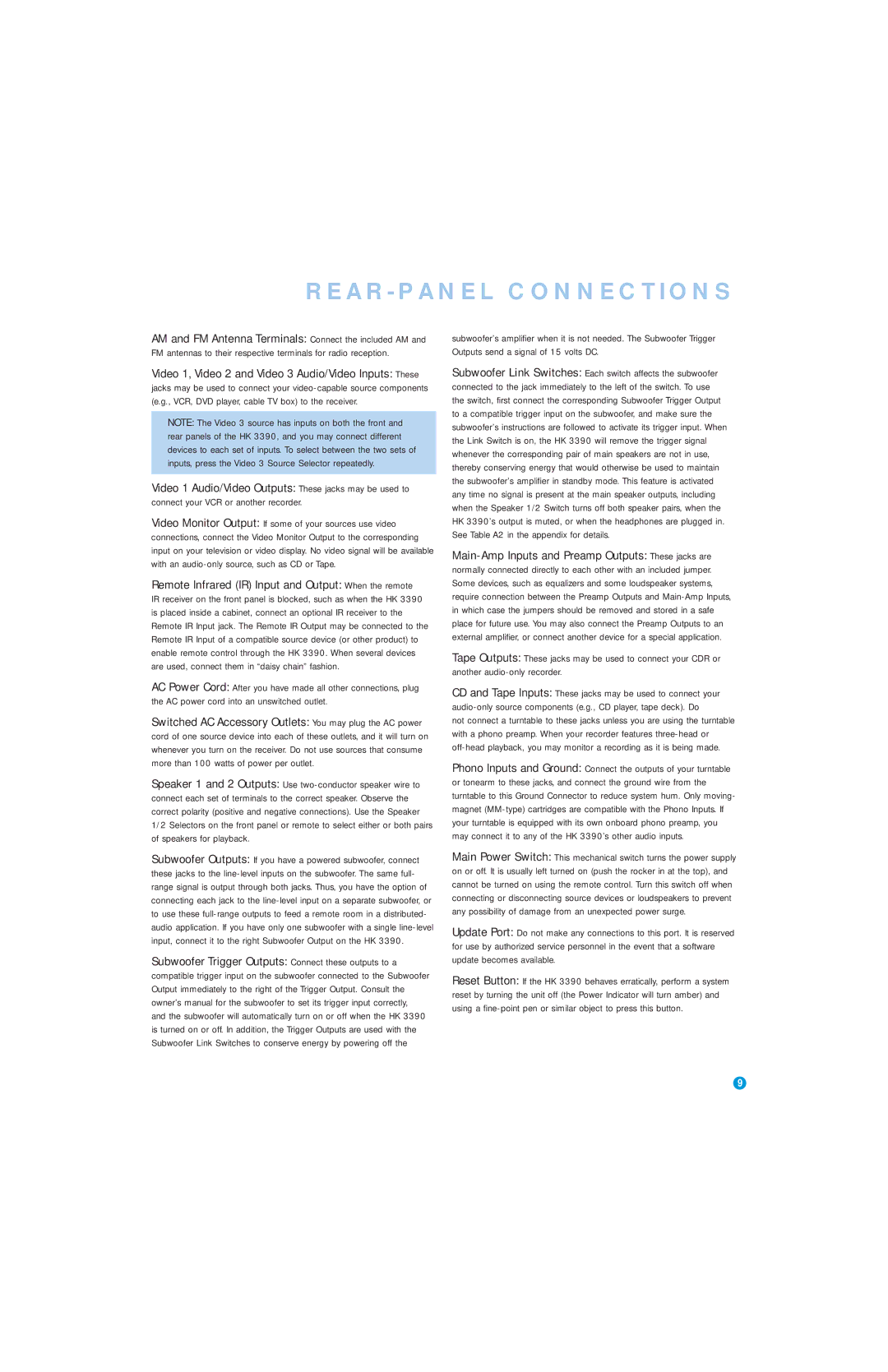AM and FM Antenna Terminals: Connect the included AM and FM antennas to their respective terminals for radio reception.
Video 1, Video 2 and Video 3 Audio/Video Inputs: These jacks may be used to connect your video-capable source components (e.g., VCR, DVD player, cable TV box) to the receiver.
NOTE: The Video 3 source has inputs on both the front and rear panels of the HK 3390, and you may connect different devices to each set of inputs. To select between the two sets of inputs, press the Video 3 Source Selector repeatedly.
Video 1 Audio/Video Outputs: These jacks may be used to connect your VCR or another recorder.
Video Monitor Output: If some of your sources use video connections, connect the Video Monitor Output to the corresponding input on your television or video display. No video signal will be available with an audio-only source, such as CD or Tape.
Remote Infrared (IR) Input and Output: When the remote IR receiver on the front panel is blocked, such as when the HK 3390 is placed inside a cabinet, connect an optional IR receiver to the Remote IR Input jack. The Remote IR Output may be connected to the Remote IR Input of a compatible source device (or other product) to enable remote control through the HK 3390. When several devices are used, connect them in “daisy chain” fashion.
AC Power Cord: After you have made all other connections, plug the AC power cord into an unswitched outlet.
Switched AC Accessory Outlets: You may plug the AC power cord of one source device into each of these outlets, and it will turn on whenever you turn on the receiver. Do not use sources that consume more than 100 watts of power per outlet.
Speaker 1 and 2 Outputs: Use two-conductor speaker wire to connect each set of terminals to the correct speaker. Observe the correct polarity (positive and negative connections). Use the Speaker 1/2 Selectors on the front panel or remote to select either or both pairs of speakers for playback.
Subwoofer Outputs: If you have a powered subwoofer, connect these jacks to the line-level inputs on the subwoofer. The same full- range signal is output through both jacks. Thus, you have the option of connecting each jack to the line-level input on a separate subwoofer, or to use these full-range outputs to feed a remote room in a distributed- audio application. If you have only one subwoofer with a single line-level input, connect it to the right Subwoofer Output on the HK 3390.
Subwoofer Trigger Outputs: Connect these outputs to a compatible trigger input on the subwoofer connected to the Subwoofer Output immediately to the right of the Trigger Output. Consult the owner’s manual for the subwoofer to set its trigger input correctly, and the subwoofer will automatically turn on or off when the HK 3390 is turned on or off. In addition, the Trigger Outputs are used with the Subwoofer Link Switches to conserve energy by powering off the
subwoofer’s amplifier when it is not needed. The Subwoofer Trigger Outputs send a signal of 15 volts DC.
Subwoofer Link Switches: Each switch affects the subwoofer connected to the jack immediately to the left of the switch. To use the switch, first connect the corresponding Subwoofer Trigger Output to a compatible trigger input on the subwoofer, and make sure the subwoofer’s instructions are followed to activate its trigger input. When the Link Switch is on, the HK 3390 will remove the trigger signal whenever the corresponding pair of main speakers are not in use, thereby conserving energy that would otherwise be used to maintain the subwoofer’s amplifier in standby mode. This feature is activated any time no signal is present at the main speaker outputs, including when the Speaker 1/2 Switch turns off both speaker pairs, when the HK 3390’s output is muted, or when the headphones are plugged in. See Table A2 in the appendix for details.
Main-Amp Inputs and Preamp Outputs: These jacks are normally connected directly to each other with an included jumper. Some devices, such as equalizers and some loudspeaker systems, require connection between the Preamp Outputs and Main-Amp Inputs, in which case the jumpers should be removed and stored in a safe place for future use. You may also connect the Preamp Outputs to an external amplifier, or connect another device for a special application.
Tape Outputs: These jacks may be used to connect your CDR or another audio-only recorder.
CD and Tape Inputs: These jacks may be used to connect your audio-only source components (e.g., CD player, tape deck). Do
not connect a turntable to these jacks unless you are using the turntable with a phono preamp. When your recorder features three-head or off-head playback, you may monitor a recording as it is being made.
Phono Inputs and Ground: Connect the outputs of your turntable or tonearm to these jacks, and connect the ground wire from the turntable to this Ground Connector to reduce system hum. Only moving- magnet (MM-type) cartridges are compatible with the Phono Inputs. If your turntable is equipped with its own onboard phono preamp, you may connect it to any of the HK 3390’s other audio inputs.
Main Power Switch: This mechanical switch turns the power supply on or off. It is usually left turned on (push the rocker in at the top), and cannot be turned on using the remote control. Turn this switch off when connecting or disconnecting source devices or loudspeakers to prevent any possibility of damage from an unexpected power surge.
Update Port: Do not make any connections to this port. It is reserved for use by authorized service personnel in the event that a software update becomes available.
Reset Button: If the HK 3390 behaves erratically, perform a system reset by turning the unit off (the Power Indicator will turn amber) and using a fine-point pen or similar object to press this button.

